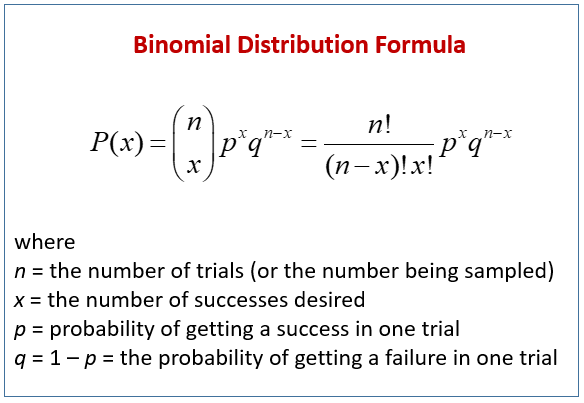Binomial Distribution | Introduction and examples
What Is Binomial
Video tutorial: Wrath of Math, 2017, YouTube
Binomial is a simplistic polynomial.
It has two terms, which could be numeral, variable, or combined element.
for example:
$3x +4$
$x+5$
$x^2 + 5x$
As you can see, they are all binomials.
What Is Binomial Experiment
A binomial experiment is a statistical experiment that has the following properties:
- The experiment consists of n repeated trials.
- Each trial can result in just two possible outcomes. We call one of these outcomes a success and the other, a failure.
- The probability of success, denoted by P, is the same on every trial.
- The trials are independent; that is, the outcome on one trial does not affect the outcome on other trials.
Cite: Stat Trek[1]
For example, the experiment about flipping a coin and counting the probabilities of each side.
Binomial Distribution
A binomial random variable is the number of successes x in n repeated trials of a binomial experiment. The probability distribution of a binomial random variable is called a binomial distribution. [1:1]
For example, when we flip a coin two times,
We can have the results:
| Result | Probability |
|---|---|
| Head * 2 | 25% |
| Head, Tail | 50% |
| Tail * 2 | 25% |
$$
b(x; n, P) = C_{n}^{x} * P^ x (1 - P)^{(n - x)}
$$
$$
C_{n}^{x} = \frac{ n!}{ x! (n - x)! }
$$
The properties of the Binomial Distribution:
- The mean of the distribution $μx$ is equal to $n \times P$ .
- The variance $σ2x$ is $nP( 1 - P) $.
- The standard deviation $σx$ is $\sqrt{nP( 1 - P ) }$.
AND- $x$: The number of successes that result from the binomial experiment.
- $n$: The number of trials in the binomial experiment.
- $P$: The probability of success on an individual trial.
- $Q$: The probability of failure on an individual trial. (This is equal to 1 - P.)
- $n!$: The factorial of n (also known as n factorial).
- $b(x; n, P)$: Binomial probability - the probability that an $n$ trial binomial experiment results in exactly $x$ successes, when the probability of success on an individual trial is $P$.
- $C_n^x$: The number of combinations of $n$ things, taken $x$ at a time.
Cite: Stat Trek[1:2]
Example 1:
Suppose a die is tossed 5 times. What is the probability of getting exactly 2 fours?[1:3]
So, we have 5 times, which means $n = 5$;
We need exactly four * 2, which means $x = 2$;
The probability of a single trial is 1/6, which give $P = 1/6$
According to the function above, we can have:
$b(2; 5, 1/6) = C_{5}^{2} * (1/6)^ 2 (1 - (1/6))^{(5 - 2)}$
In R, we can calculate the binomial with the function dbinom as dbinom(2, 5, 1/6).
Now we have the results:
$b(2; 5, 1/6) = 0.160751$
Example 2:
$b(x; n, P) = \frac{ n!}{ x! (n - x)!} \times P^ x (1 - P)^{(n - x)}$
Let’s back to the coin.
When we flip it once, and the chances of Head is obviously 50%.
Which is:
$b(1; 1, 1/2) = \frac{ 1!}{ 1! (1 - 1)!} * 0.5^ 1 (1 - 1)^{(1 - 1)}$
$b(1; 1, 1/2) = 1 * 0.5 * 1$
$b(1; 1, 1/2) = 0.5$
When we flip it twice, we can have 4 results: HH, HT, TH, TT
- the chance we have only one head is
dbinom(1, 2, 1/2), which is 50%. (HT, TH) - the chance we have two heads is
dbinom(2, 2, 1/2), which is 25%. (HH) - the chance we have heads from 0 to all is:
0.25, 0.5, 0.25, which means
$1: 2:1$
Now, let’s try to flip it triple times, so we have 8 results:
HHH, HHT, HTH, THH HTT, THT, TTH, TTT
-
one head: HTT, THT, TTH: $3/8 = 0.375$
$b(1; 3, 1/2) = \frac{ 3!}{ 1! (3 - 1)!} \times 0.5^ 1 (1 - 0.5)^{(3 - 1)}$
$b(1; 3, 1/2) = 3 \times 0.5 \times 0.25$
$b(1; 3, 1/2) = 0.375$ -
two head: HHT, HTH, THH: $3/8 = 0.275$
$b(2; 3, 1/2) = \frac{ 3!}{ 2! (3 - 2)!} \times 0.5^ 2 (1 - 0.5)^{(3 - 2)}$
$b(2; 3, 1/2) = 3 \times 0.25 \times 0.5$
$b(2; 3, 1/2) = 0.375$ -
the chance we have head from 0 to all is:
0.125, 0.375, 0.375, 0.125, which means
$1:3:3:1$
With the increase of the flipping number to 10, for instance, we can have the ratio:
|
1
1 1
1 2 1
1 3 3 1
1 4 6 4 1
1 5 10 10 5 1
1 6 15 20 15 6 1
1 7 21 35 35 21 7 1
1 8 28 56 70 56 28 8 1
1 9 36 84 126 126 84 36 9 1
1 10 45 120 210 252 210 120 45 10 1
Poisson theorem[2]
When The $n$ is infinite large, we can have:
$$
\lim_ {n \to \infty} C_ n ^x P^ x (1 - P)^{(n - x)}, x = 0, 1, 2, …
$$
Let’s say, $nP = \lambda $
When the $n$ is very large and the $P$ is infinite small, we can have:
$$
C_ n ^x P^ x (1 - P)^{(n - x)} \approx \frac{\lambda ^ x}{x!} e^ {-\lambda}
$$
I have no idea how it works. So, I’m gonna stopping here.
Binomial Distribution | Introduction and examples








